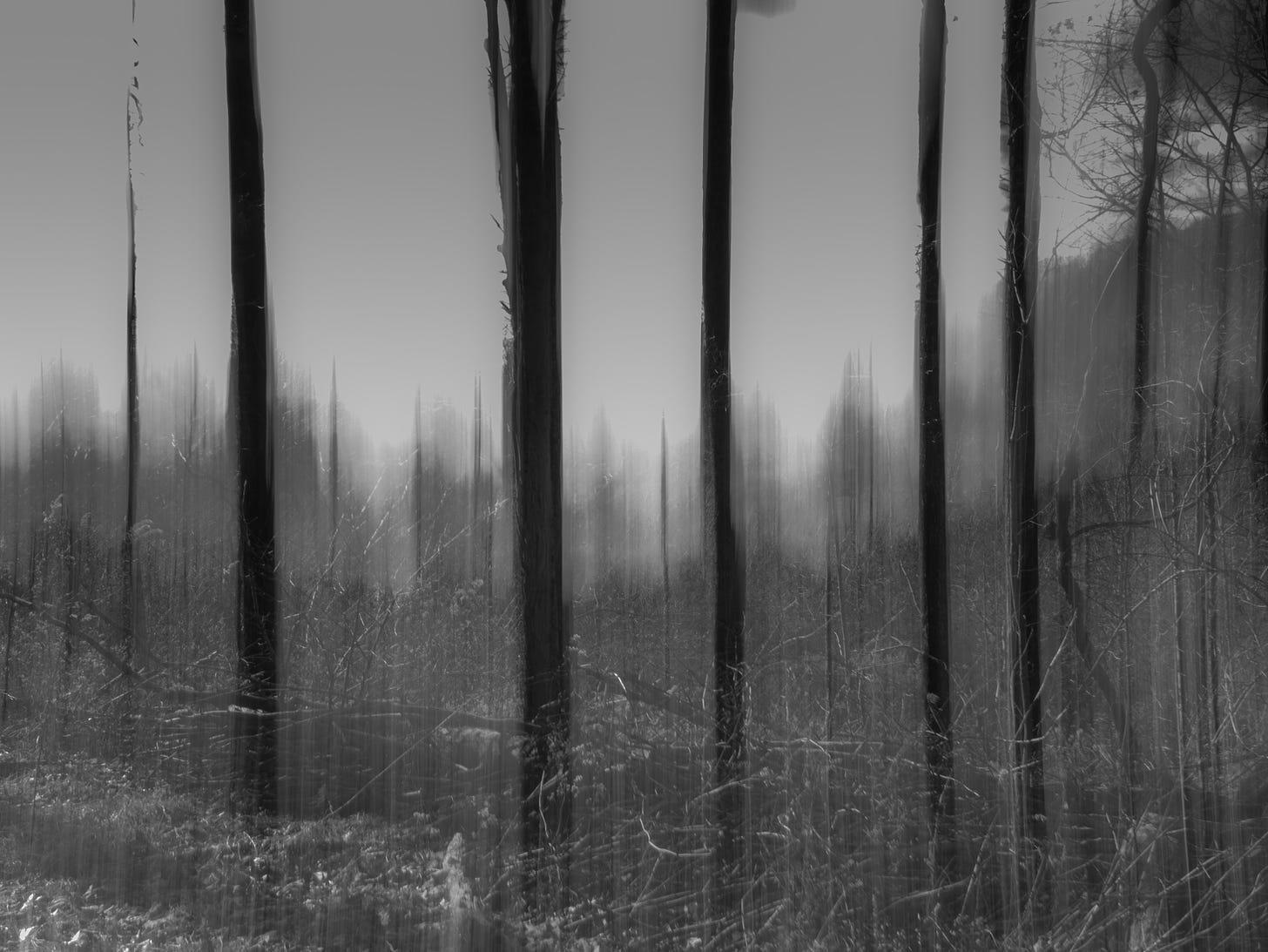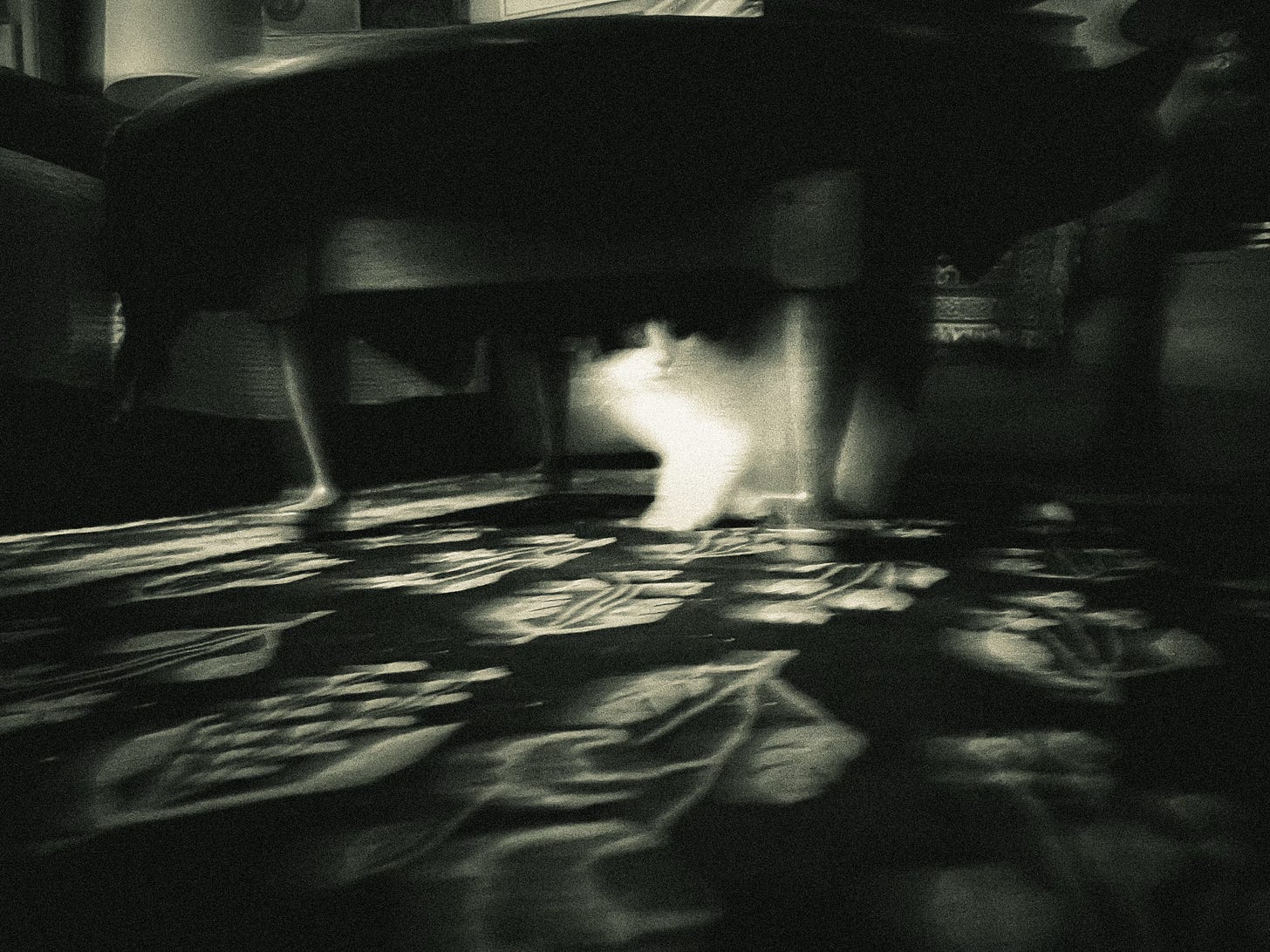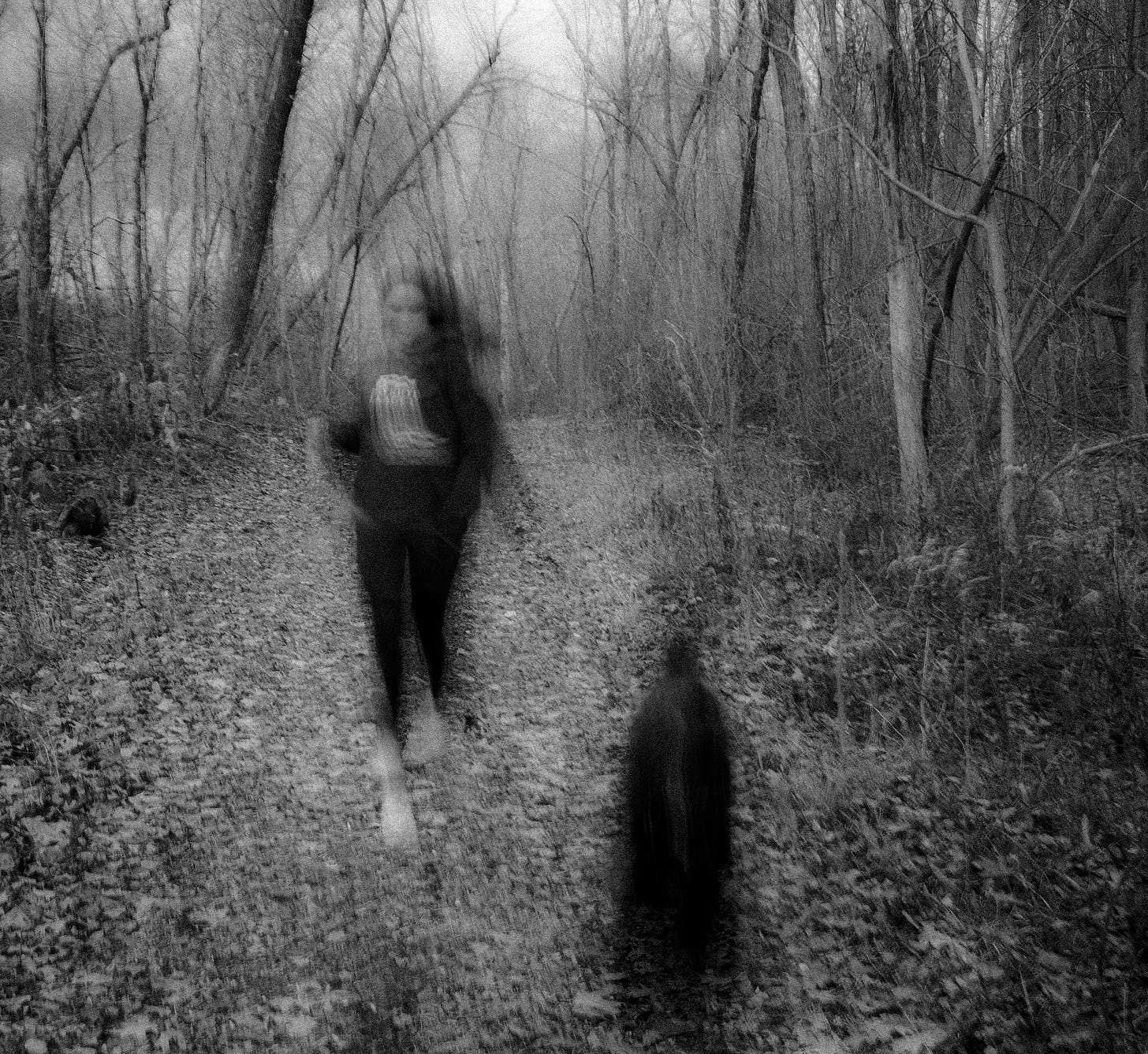It should come as no surprise that I would eventually shift toward the abstract in my fledgling efforts at photography given my love for the surreal, the abstract, the expressionistic in art. I have quite suddenly found myself asking, “why strive for ‘realism’ at all—the high pixel count, crisp, noise-free, perfectly focused shot?” Beyond this, I now find myself wondering if these things even constitute “realism” at all. How often is it that you see every minute edge of every bird feather, the breath of a red-winged blackbird, the frozen-in-time angling wings of an owl descending toward its prey?
In a recent photograph I took of some small diving ducks (buffleheads) who had gathered on a nearby reservoir, I crept through daunting poison ivy vines and lakeside bramble to get a series of shots using a long lens. I set the shutter speed high, so it would open and close within a hard-to-envision one thousand six hundredth of a second—to guarantee precise, blur-free images. In one photo, I managed to freeze a diving bufflehead just after his head had gone under, his tail wings spread wide, an array of water droplets frozen mid-air. Given that I “saw” none of this with my eyes, is this photography truly “realistic”? Do sharply focused, zoomed-in freeze-frames in time really only offer something more like the things we view through the lenses of microscopes, things beyond the “realistic” scope of ordinary vision? And why, when I look at that image am I more intrigued emotionally by the blurred branch in the foreground (looking oddly like Hawthorne’s magically hovering letter A in the sky), reminding me how I had crouched low and pushed my lens as best I could through the tangle of branches to get the shot at all?
One daunting aspect of photography I sometimes grapple mightily with is that the sharper the image, the higher the pixel count, the more stabilized the camera body and lens, the more optically exact the lens glass…the higher the price. For a high quality, full frame mirrorless digital camera and a few essential lenses, one could easily spend upwards of $10,000. And yes, the priciest equipment coupled with an operator who has mastered the triad of shutter speed, aperture, and ISO, and the complexities of post processing…certainly does result in breathtaking images.
And I have spent many a late night YouTube surfing session watching videos on how to discover the best F-stop for the sharpest image of a given lens, how to intersect Adobe Lightroom masks for the perfect effect, how to use color grading and tone curves and color calibration and new denoising AI features…. I have watched lengthy, technical reviews of cameras and lenses forever out of my reach since deep in my bones resides a tech-nerd who just likes knowing about the ever more magical technological advances human beings make (even as we can’t figure out how not to brutally kill each other, no more advanced than your average cave-person).
Recently, sipping a favorite mezcal, Charlie, my Gordon Setter, curled into his late night tortellini sleep position, a video on the “blurred street photography of Olga Karlovac” appeared in my feed. The preview was a slideshow of her black and white photographs, which instantly compelled me to click into the full-screen view of the video. I paused the video on certain shots, elongated, ghost-like, slanting figures set against the silhouettes of buildings, the eerie pulse of streetlamps, closeups of blurred faces emerging from black-black backgrounds, streaks of swirling white, a nearly in-focus set of eyes…each image evoking something far more complex than the simple emotion of being impressed by the precision and exactness of a perfectly focused, mega-expensive, mega-megapixel camera and smart, talented photographer and photo editor.
The image above, in particular, grabbed me as I researched her work further online. A figure (a woman it seems to me), walks toward you, close to the wall of a building. Her face—the whole front of her—is all black. Streaks of back-lit white catch the back of her head, legs, arm. Far behind her, a few other figures are barely visible, just emerging from the strong light source out of frame. She is elongated, her head stretched into something nearly triangular. One foot is a blurred, black V. From the blurred, round tip of her other foot, her shadow rushes forward.
The image evokes a sense of fear, urgency. The slashes of lines made by intentionally sliding the camera at an upward or downward angle as the shutter is released create a tension with the long diagonal created where street meets wall that nearly bisects the image. Perhaps most significantly, the minutiae of detail the eye (or a camera using a faster shutter, a higher ISO, a wider aperture) would be able to take in are not present—the textures of the street, the walls of the building, eyes, mouth, nose. Fingers would be more than just indistinct smudges of light, or is she carrying something? All of these lacking details and uncertainty force you to contend with the macro dynamics of it all, the essentials—a figure rushing forward, holding close to a wall, moving away from a bright light toward darkness…. And these may well be the things your eyes would register were you seeing it yourself standing alongside Karlovac snapping the shot while carefully sliding the camera upward.
Perhaps I was responding precisely to the “reality” of this seeming unreal image, this momentary, emotion-filled glimpse that may well constitute the way we really “look” at things, how we experience our lives.
Technically speaking, I guess you should call these photographs “expressionistic,” in that enough has been manipulated from the actual, visual experience so as to express an emotion onto the image. More commonly in photography circles, this kind of thing is simply called “impressionistic” or “abstract,” these words only indicating that the artist is doing something closer in look and feel to a painting. Regarding “impressionistic,” I have trouble using that term for Karlovac’s work since color was such an essential component of impressionist painters. When Monet’s waterlilies blur and show obvious, intended strokes of his brush, splashes and layers of paint (just as Karlovac’s images show the intentional streaks left from the motion of the camera), they still retain the greens and blues and magentas and colors in between we have no names for of the original experience of the gardens at Giverny.
Might we say more simply, rather than search for the perfect term, that images like these all work to capture the essence of a moment, the center of an emotional, human response? Might the (expensive) technological wizardry of modern photography work to pull us away from the more analog dynamics of human experience?
I do know I have recently experienced a kind of reenactment of art history in miniature over the past year with my photography. Last year I sold several old point and shoot cameras and an early, woefully low-pixel-count DSLR and lenses and scraped together enough cash to get a circa 2016 micro four-thirds, mirrorless camera and a few lenses (thinking at the time, that I needed to bring my gear up as close to “modern” standards as possible). I am now evolving from trying for the kind of precision of the “ultra-realism” of 19th century painters to studying the nuances and challenges of ICM (intentional camera movement—yes, it has a name!), working to create “painterly” photographs, more like 20th century Expressionism (or 21st century Karlovac). Next, possibly, will be the still more challenging attempt to create art that bears no obvious representation of human perception at all, a more purely abstract approach, which some of my images are already inching toward.
It all began after watching that video on Karlovac. Right away, I pulled out my smart phone, turned off the flash, held it low to the floor and pointed it cat-ward, where Cleo was hunched beneath the coffee table. I gave the phone a swish and a jiggle as the shutter clicked open, then closed a full second later. The first iteration of the image was nothing special—a blur of black and white fur barely visible in the shadow of the table. When I opened the image in my mobile photo editing app, brought up the exposure below the table slightly, shifted it into monochrome, tweaked contrast, whites, blacks, added some vignetting…I was astounded. Somehow this photograph came closer to capture something about the character of Cleo—a cat who had gone nearly feral living outdoors near a local barn when we first took her in. That look and the implied motion, she always ready to dash away, her bratty, self possessed attitude, her lack of trust and willingness to scratch or bite with the least provocation, even as she will also sometimes burrow into your chest, rumbling out a loud purr…all were somehow “caught” through the imprecision of the blurring together of a second in time rather than the instant, clear, crisp capture of a tiny slice of one second. In the less “precise” image, the “unfocused” image, I found that my own eyes had more to do, and that the image had somehow managed to be more precise emotionally even as it was less precise photographically.
I turned the smart phone camera toward Charlie, who woke in that same instant and started to lift his head, his motion off-setting the camera enough to allow portions of that loving eye, the thin white streak of a line swirling from it, to become the “center” of the emotional experience of the image.
I read more, watched more videos, took a deep, exciting dive into yet another thing in this world I somehow knew nothing about. Soon I found myself on a long walk on a sun and cloud filled windy-cool November afternoon with my daughter, Sofia, Charlie, and my camera fitted with a fixed, 25mm lens, a darkening filter screwed on (slowing shutters means letting in more light and potentially washing out the whole of the image if you’re not careful), and hiked a nearby abandoned road then up onto the hiking trails that traverse Mad Mare’s Ridge past the stone framework of an old, long-ago burned down homestead.
I took dozens of shots, experimenting with different shutter speeds and F-stops and camera movements. Sofia would periodically run ahead with Charlie then back again in an effort to stay warm, and Charlie would occasionally bark a bratty bark if I paused for too long staring down at that strange little black box of a thing dangling from my neck.
When I returned home, I was excited to pull up the images on my computer. Working through them in Adobe Lightroom, I found my normal editing flow didn’t work at all, that they demanded something different from me at all stages of the process. I was still doing the kinds of things one normally has to do to process a RAW image, but with the final objective fundamentally changed, the software editing tools needed to be used in new ways as well. I’ll spare you all the details, but suffice it to say that I worked to complement and urge out of the image the emotion I could feel residing in it, something central to it, something like an artist working to find the sculpture residing in the chunk of wood or marble.
As each image emerged into what it wanted to be, into what I saw/felt/experienced emotionally when walking along, looking through the lens…I was filled with a feeling I haven’t yet encountered when processing photographs. I felt something more akin to what I feel when I write a good line of poetry—a moment of awe and wonder that something new and beyond me had somehow emerged from within me.
Above is that first image I “developed” (and I’d urge you to look at these on your computer and click on the image to enlarge it). The original, RAW image was flat and uninteresting, but just shifting into the Develop module instantly changed all of that. When I had stopped and turned the camera toward the forest (to Charlie’s chagrin), I was struck by the undulating shapes of tree trunks, the layers of them along the plateau we hiked at the top of the ridge, how the light moved differently through them than it would have in a low woodland. I set the shutter to 1/2 a second and swept the camera upward smoothly as I pressed the shutter release. That simple gesture, combined with the ten minutes or so I spent editing resulted in an image that somehow managed to capture something centrally important to what I always feel when hiking these high, forested ridge lines, especially in the late fall, the leaves mostly gone, the forest floor gone all brown and tan and yellow with its layers of fallen leaves.
The green of sparse mountain laurels at the direct center of the image are nothing more than green blurs here—much as you are aware of the evergreen bushes at the corner of your eye as you move through the monochromatic November forest. If you look closely toward the right of the image, you’ll find a thin streak of blue, this the small square blue mark of the trail, showing the half-second motion of my camera that brought all this to life, taking all those vertical lines of tree trunks and the wash of leaf fall and somehow representing them nearly as precisely as what they evoked in the moment. A more carefully focused image would also have shone the intricate lacing of all of the branches, distracting you from what I was noticing, all those twists and turns of tree trunks, a splash of green, the far off shimmer of the high light of the ridge….
It seems a bit silly as I write this that something so relatively simple can spark such a barrage of thoughts and such a desire to get back out there and do more of it. Work for purposeful blurring rather than purposeful sharpness. Invert the paradigm. Voila, art. I know it’s not that simple. I also continue to find inspiration in more traditional photography and will forever be awed by images that clearly show compositional purpose and wed the most nerd-worthy technical advances of modern equipment with deeply powerful artistry. Then there’s always the possibility that these images are only pleasing to me, that they only evoke something in me, and since I don’t consider myself a “photographer,” I’m OK with that. I proudly called Sofia to my computer to look at the woodland image above, and she simply said, “Cool, but it gives me a migraine.”
I’ll leave you with some images I’m most pleased with from the walk. I’m especially fond of the first image below, Sofia turned toward me, running, Charlie nothing more than a blob of black (I wasn’t seeing him, not with Sofia visiting for such a short time after too long away), Sofia focusing hard on where she’s going, the dog urging her forward a little faster than she liked, a celebratory, girlish joy (something she always exudes; something I love so deeply about her) all coming through.



If you’ve been enjoying my writing, please consider doing any/all of the following:
Help me grow my audience by Sharing this post or my main site with a few people you think might enjoy it as well.
Upgrade your subscription to paid. For only $.14/day, you can help me continue to devote the many hours I do each week to writing, editing and promoting this page.
JourneyCasts is a reader-supported publication. To receive new posts and support my work, consider becoming a free or paid subscriber.
You can also help a lot by making a one-time contribution at any time by “buying me a coffee” (or two). And certainly a good amount of real coffee has gone into the making of JourneyCasts.
As always, I encourage you to leave a comment.
Be sure to check out my podcast, “Hemingway, Word for Word.”











Love these photos!
I am so excited for you and love the pictures; you’re sharing the effort. Can’t wait to see more!